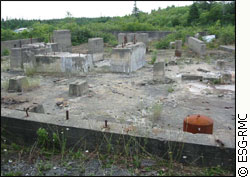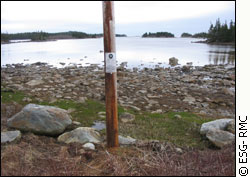| Cleaning
up Canada one step
at a time
By Jennifer Young
OTTAWA —
Ken Reimer’s goal is
to clean up Canada, one contaminated site at a time.
Reimer is a professor in the Department of Chemistry
and Chemical Engineering at the Royal Military College
of Canada in Kingston and he also teaches at Queen’s
University.
 |
| One of the more obvious comtaminated
sites in need of remediation. |
When Reimer is not teaching students,
he is working towards cleaning up and assessing Canada’s
contaminated sites. He is the director of the Environmental
Science Group, an organization which he founded 16 years
ago.
The group is now 70 full-time members
strong. The members of the team each vary in their scientific
expertise. "To look at the environment, you need
a very multi-disciplined approach," said Reimer.
The group is currently working on
a number of projects. Its main focus is cleaning up
the sites of the Distant Early Warning or DEW Line.
These sites are no longer in use but need remediation
in order to keep contaminates, currently in the soil,
from affecting the people and the area around the sites.
"We're looking at what impact the chemicals might
be having," said Reimer.
Working challenges
His biggest challenge in this line
of study is logistical. Everything has to be airlifted
to remote locations in Canada’s far north. "Every
year we bring 15 to 20 thousand samples back here,"
said Reimer.
The group also does risk assessments
of land to determine if it poses health problems for
the inhabitants. "We're looking at sites in the
new land claim area," said Reimer, whose group
is currently testing the soil on Labrador Inuit lands.
 |
| One of the less obvious contaminated
sites. |
This assessment is necessary because
sites can range from old gas stations to former industrial
plants and beyond. "A contaminated site is not
always so obvious," said Reimer which is why a
piece of land, like the one in Labrador, has to be assessed.
He said that a contaminated site could seem fine, but
be just down stream from an industrial plant.
Assessing risk
He also said that the amount of
a chemical in the soil does not necessarily make it
a danger to those around it. "The mere presence
of chemicals does not mean it poses a risk."
For example, Yellowknife has natural
deposits of arsenic in its soil that are more than ten
times the acceptable limit. Reimer says, that level
is normal for that area and actually not as threatening
as other sites with lower, unnatural levels.
Reimer also said that in order for
a site to be a risk, it must contain three things: the
chemical, then a receptor, usually humans, and finally
a way for the receptor to come in contact with the chemicals.
Reimer says that the most effective
way to determine the risk posed by a site is to test
the bioaccessibility of the chemicals in the soil.
"I would like to see bioaccessibility
included in environmental regulations," said Reimer.
He believes this will happen soon.
Bioaccessability is the measure
of how much of a chemical from the soil makes it into
the gastrointestinal tract. Its presence in the gastrointestinal
tract, however, does not mean that the chemical will
make its way into the blood stream. This would be the
bioavailability of a chemical, but science cannot test
for this just yet.
"In many cases the two terms
are equivalent," said Reimer, using arsenic as
an example. If soil containing arsenic is ingested,
almost 100 per cent of the chemical that gets into the
gastrointestinal tract is absorbed into the blood stream.
In contrast, only 30 per cent of nickel makes it into
the blood stream.
Any amount of chemical in the soil
is often perceived as a threat to the public. Reimer
said that this is one of the biggest challenges with
his work. He said that most provincial and municipal
officials are leery of notifying the public about contaminated
sites.
Reimer said that the key to risk
management is communicating the risk to the stakeholders
as early as possible. "When you build trust, people
will be more able to accept the site," said Reimer.
Plans for the future
Reimer plans to continue with his
work in the future. "I just want to do more of
the same," said Reimer.
| 'When
you build trust, people will be more able to accept
the site.' |
This plan is plausible since, as
of 2003, there are officially 4325 federal contaminated
sites. The government is planning to spend approximately
$3.5 billion over the next 10 to 15 years to clean them
up. Reimer expects the DEW Line project alone will take
at least 10 more years to complete.
He also expressed the pride he feels
when he flies over a radar site that was part of the
DEW Line and is now clean. "You hardly know it
was there," said Reimer.
|